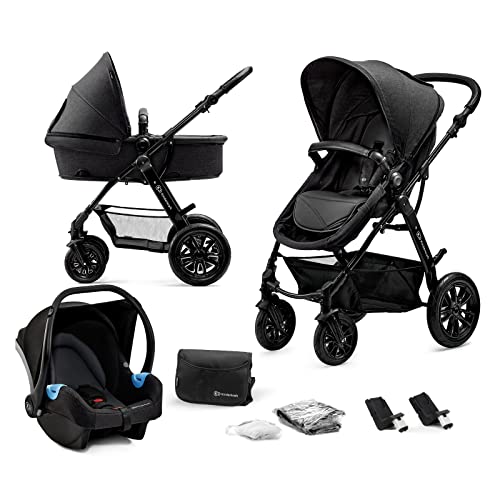7 Things About Pushchair And Pram You'll Kick Yourself For Not Knowing
Understanding Pushchairs and Prams: A Comprehensive Guide
When it concerns baby mobility, the terms “pushchair” and “pram” are often utilized interchangeably. Nevertheless, they represent distinct types of baby providers, each engineered for particular stages of a kid's advancement and varied parental needs. This post explores the critical distinctions in between pushchairs and prams, their features, types, and factors to consider for brand-new moms and dads.
What is a Pushchair?
A pushchair, typically known as a stroller in some areas, is designed for children who can sit up individually. Typically, pushchairs are modern-day, lightweight, and have a seat that can be reclined for added comfort. They might also include a five-point harness to make sure the kid's security while on the go.
Key Features of Pushchairs
- Light-weight Design: Most pushchairs are made from lighter products, making them easy to maneuver and transport.
- Adjustable Seats: Many models use recline choices, accommodating resting or active positions.
- Canopy: Most pushchairs come geared up with a sunshade or canopy to protect the kid from sun exposure.
- Storage Space: They typically include a lower storage basket, best for holding diaper bags or shopping.
Common Types of Pushchairs
- Requirement Pushchairs: Traditional choices ideal for kids who can sit independently.
- Umbrella Strollers: Lightweight, compact, and simple to fold; perfect for taking a trip.
- All-Terrain Strollers: Built with bigger wheels for off-road capabilities and smooth trips on diverse surfaces.
- Travel Systems: Combines a stroller and an infant vehicle seat, enabling parents to move their kid perfectly.
What is a Pram?
A pram, short for “perambulator,” is mostly designed for babies, normally from birth up until roughly 6 months. Prams are structured with a flat lying position that supports a newborn's anatomy, guaranteeing they are nestled properly.
Key Features of Prams
- Flat Bed Design: Prams have a fully flat bed, which is essential for young babies who require to lie flat for convenience and health.
- Stylish Aesthetics: Many prams boast vintage or timeless designs, typically seen with luxurious materials and appealing finishes.
- Suspension System: Quality prams frequently consist of a suspension system to offer a smoother trip over rough surface.
- Extended Canopy: Extended sun security and rain covers prevail.
Common Types of Prams
- Classic Prams: Featuring a conventional style, these are often styled to evoke fond memories.
- Convertible Prams: These can quickly change from a pram to a pushchair and normally grow with the kid.
- Lightweight Prams: More compact than traditional prams, making them easier to transfer.
Distinctions Between Pushchairs and Prams
Function
Pushchair
Pram
Usage Case
For kids who can stay up
For newborns and infants
Design
Upright seat with reclining alternative
Flat bed for lying down
Weight
Typically lighter
Much heavier due to durable building
Density
Folds easily and compactly
May be bulkier, depending upon design
Age Range
6 months to 4 years or older
Birth to approximately 6 months
Price Range
More cost effective choices available
Often more expensive due to materials and design
Selecting Between a Pushchair and Pram
When picking between a pushchair and a pram, numerous elements necessitate consideration:
- Age of the Child: Newborns require a pram; older babies and young children will be more comfy in a pushchair.
- Lifestyle Needs: Parents who travel typically may choose light-weight pushchairs, while those looking for comfort in style may favor prams.
- Budget plan: Prams can vary from moderately to pricey; trustworthy pushchairs can cater to budget-conscious shoppers.
- Storage Space: Consider how quickly the picked design can suit your cars and truck trunk or home storage.
Frequently asked questions
Q1: Can I use a pushchair for a newborn baby?
While specific pushchairs are designed with reclining functions that may accommodate infants, it is generally advised to utilize a pram or specially developed infant automobile seat for newborns.
Q2: Are travel systems worth the investment?
Travel systems can provide benefit by integrating a cars and truck seat and a stroller. They permit seamless transition from automobile to stroller, which numerous moms and dads discover vital.
Q3: How do I keep my pushchair or pram?
Regularly tidy the material, check for mechanical concerns, and lubricate the wheels. Ensure to follow specific care instructions offered by the manufacturer.
Q4: What is the weight limitation for pushchairs and prams?
Weight limits differ by design: usually, pushchairs accommodate approximately 50 lbs, while prams fit babies as much as 30 pounds. Constantly refer to the manufacturer's guidelines.
Q5: Is it necessary to have a rain cover for my pushchair or pram?
Yes, a rain cover can secure your child from rain and wind, preserving convenience while preventing wet clothes.
In summary, pushchairs and prams serve essential but unique functions in the mobility landscape for moms and dads and caregivers. Choosing pushchairsandprams depends on the kid's age, way of life requirements, and family choices. By comprehending the attributes, benefits, and differences between pushchairs and prams, moms and dads can make educated decisions that ensure convenience and security for their kid. Whether strolling through the park or browsing hectic streets, the best mobility solution is out there waiting.
